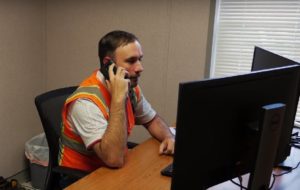Features - Business
Telematics to drive construction industry revolution

Advances in technology are transforming the construction industry. From digitisation to drones, innovative new technologies are helping to increase quality, reduce costs and improve safety in all areas.
John Cameron, General Manager of Trimble Field Service Management, believes that the Internet of Things is poised to radically change the way service and maintenance operations are performed on equipment within the construction industry and sees telematics-driven connected workflows as being the key enabler for preventative maintenance. In this article, he discusses these latest innovations and the effect they are having on construction.
The Internet of Things is poised to radically change the way service and maintenance operations are performed on equipment within the construction industry. Whether equipment is owned, leased or rented, pressure is put on maintenance and repair teams to perform tighter SLAs. Construction jobs run on tight margins and have a lot of cross-dependencies between tasks. A broken piece of equipment can bring the entire project to a halt, causing loss of work and, ultimately, income.
A big focus has therefore been put on the Internet of Things (IoT) for preventative maintenance. Gartner agrees, stating that field service management processes must change to benefit from IoT devices and that he expects there to be 20 billion internet-connected things by 2020.
Telematics a key enabler for preventative maintenance
Advances in telematics technology are at the heart of the IoT for field service management revolution. Once regarded as being the basis for tracking the location of vehicles, today it can be extended to connect the entire service workflow. Indeed, telematics today can share real-time information and connect mobile workers in the field with the back office, customers and equipment.
When combined with deeper analytics systems, telematics-driven connected workflows offer a plethora of benefits to both construction businesses and equipment rental companies. One such benefit is switching the service model from a reactive, break-fix workflow to a preventative and, ultimately, predictive model. These advanced workflows require a tight connection from the asset/equipment to the service management system and telematics is the best candidate for providing this connection.

How it works
Many assets and equipment today are equipped with sensors, connected to cloud software, that can monitor telematics data. This data can include machine operating hours, the state of the motorised parts and health information such as faults and diagnostic codes. Any unexpected behaviour is visible remotely to the service or rental provider, including its exact location. The equipment sensors can automatically trigger a service call when it needs something repaired or is due for maintenance.
The future of operational efficiency lies in detecting and performing maintenance before failures occur. That way, service/rental organisations are not forced to react to emergencies after equipment has failed and construction businesses don’t have to deal with the more serious damage that can occur as a result of the domino effect a single failure can cause.
This proactive way of working allows service and rental companies to control their operations and solve equipment problems faster, whilst the construction company can get the most out of the equipment.
What’s more, adopting a preventive and predictive approach to service and maintenance as opposed to a break/fix service structure maximises the long-term usage. In the event of a vehicle, asset or piece of equipment breaking down, real-time intelligence about its location enables businesses to retrieve it for service immediately whilst a nearest available asset can be identified and reallocated, helping to minimise downtime. Furthermore, many businesses track service vehicles alongside assets and they can often be viewed on the same map. Identifying the nearest service technician to a broken down asset therefore becomes a simple task and this can improve response time considerably.
There are still many advantages to deploying telematics to connect assets even with break-fix workflows. Understanding the condition of the asset before deploying a technician will improve first time fix rates; which will drive higher customer satisfaction. This is often the first step in changing the service model.
Connecting assets from multiple suppliers
A challenge many construction businesses need to consider is how to connect to assets from multiple suppliers. Each supplier often has their own proprietary systems that have different data formats which make integration difficult and time consuming.
The construction industry is starting to incorporate data standards that help alleviate much of the effort required to establish connections to the assets. One such standard is the Association of Equipment Management Professionals (AEMP). A standard protocol was recently adopted that allows for fault code and other information to be shared in a standard way. This standardisation helps create more interoperability in the market and will surely be a boost to connected workflows in this market.
Maximize equipment utilisation across job sites with telematics
The case for telematics technology to considerably improve the utilisation of assets and equipment across job sites is a simple one. Businesses can monitor the location of their assets on demand and generate utilisation reports to determine which are being under-utilised across sites. With this information, they are better placed to determine how best the assets should be deployed, if any should be reallocated, which types of equipment customers need most and compare owned to rented asset usage – streamlining the efficiency and profitability of their asset-dependent business.
Having the ability to monitor assets and equipment on demand can also help jobs remain on track. If an urgent job comes in that requires an asset be reallocated immediately, any idle units or those closest to the construction site can be identified and reassigned to ensure delays are not incurred.
What’s more, the ability to create accurate utilisation reports for each job site can help businesses to improve job bids and win more business. Knowing the actual hours it takes to build a parking lot of a particular size or a certain scale of building helps companies to bid competitively and can mean the difference between winning and losing a contract.
Prevent the loss or misuse of assets and equipment
A major challenge construction businesses face is the loss or theft of expensive equipment due to it being abandoned, misplaced or stolen once it reaches a job site. Over 10,000 high valued construction assets are reported as stolen annually, causing the annual cost of construction equipment theft to reach $1 billion.
Businesses equipped with telematics can significantly maximise recoverability rates. They are able to quickly locate their assets, eliminating time spent searching for missing equipment and avoiding the need to replace lost assets.
Many telematics solutions incorporate functionality that ensures that if an asset or piece of equipment changes location or has been disconnected, an alert will be emitted and the equipment or branch manager will receive an exception notification. This helps them to minimise misuse and theft as they can locate the asset immediately and act quickly to retrieve it.
The future of telematics
The future for telematics is certainly bright. As businesses within the construction industry increasingly look to extend their telematics capabilities to track their vehicles, workforce and assets, investing in telematics driven connected workflows, combined with deeper analytics systems, will reap many benefits. We will see businesses switching the service model from a reactive, break-fix workflow to a preventative and, ultimately, predictive model. What’s more, businesses ultimately need to ensure that they are allocating and using their equipment across sites as efficiently as possible. Those that do not have the visibility into the status of their assets to determine this will be much more prone to costly inefficiencies. These advanced workflows require a tight connection from the asset to the service management system and telematics is integral to providing this connection.
[1] *The National Insurance Crime Bureau (NICB)
If you would like to read more articles like this then please click here.
Related Articles
More Features
- Ten years of progress on payment, pre-qualification and skills
19 May 25
The industry has made significant progress on late payment, pre-qualification, and competence since the formation
- Pagabo provides clarity on impacts of new NPPS and PPNs
12 Mar 25
The Labour government’s new National Procurement Policy Statement (NPPS) sets out strategic priorities for public
- How is the Procurement Act going to drive social value
24 Feb 25
The regulations laid out within the Procurement Act 2023 will go live today.






